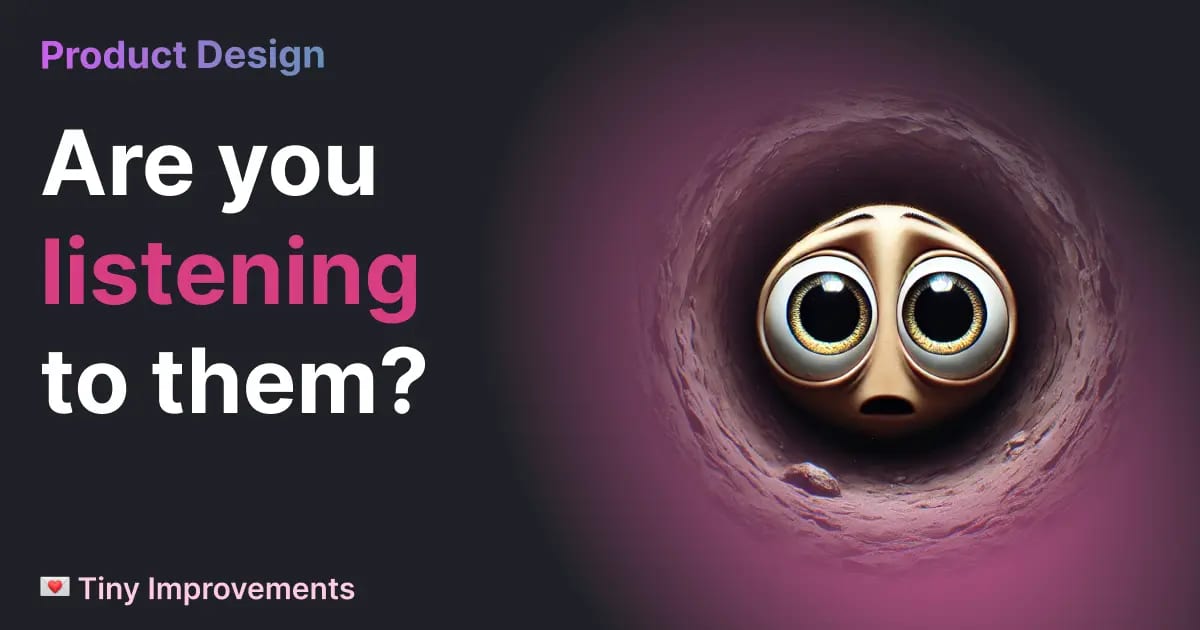- Home
- Newsletter
- Don't just listen. Interpret feedback wisely.
Don't just listen. Interpret feedback wisely.

Communication is everything
Many products stumble, or fail to take off because builders don't incorporate feedback, missing the mark on real user needs. If your success depends on real people paying for it, you need to listen to them, to make sure your product resonates and delivers value. This doesn't mean blindly following every request, instead you need to interpret it through the lens of your product vision to make meaningful change.
If you haven't done this before, it can be intimidating to start. Here's a few tips to get you started:
User Interviews
User interviews are a powerful tool for collecting in-depth insights into the needs and behaviors of the real people who are either using your product, or who you think might be part of your target demographic. These are real conversations with real people, and they require you to take the time to talk to them. One of the most important things taught at Y Combinator is that not enough founders talk to users before starting to build products.
The best user interviews are conducted with open-ended, inquisitive questions. The aim is to explore peoples' perspectives, without leading them to a specific answer. A common pitfall is to be too focused on the result you want to hear, instead of truly understanding the peoples's perspective.
Good user interviews, especially early ones, can have meaningful and significant effects on the early direction of your product. The goal is not to have one or two interviews, but to talk to as many people as you can, until you have a good understanding of the landscape.
Open channels for feedback
There are countless ways to collect feedback from people while they are using your apps. Surveys, contact forms, and feature suggestion tools give customers a way to share their desires, problems, and feature requests proactively. You've heard me talk about this before - I've had success using everything from a simple email address to surveys with PostHog. Other channels, such as chat interface tools like Intercom and Drift can also be incredibly effective for real-time feedback and support.
The real magic here lies in human connection - people will trust you more and become more attached to the product you're building when they feel like they're being heard. In the early days, it's the best way to turn casual users into loyal advocates who not only provide feedback, but actively promote your product.
Telemetry
Telemetry is an unobtrusive way to collect data on how users interact with the features of your product. By measuring user actions and behaviors, you can identify patterns, detect frustration and issues, and make informed decisions on how to improve the product. Telemetry doesn't need to be creepy; it can be done anonymously, providing valuable feedback without compromising user privacy.
This way, you can gain insights and improve your product while respecting boundaries.
Telemetry can be used to monitor the success of new features, system performance, and proactively address bugs before customers churn.
Don't forget about the vision
Every product founder should build with a believe in the vision that sparked their journey. It's this vision that should guide you through the feedback you're getting, ensuring that you remain true to your long term goals, and delivers a product that is truly useful, even if it evolves over time.
As you gather feedback through user interviews, feedback channels, and telemetry, it's easy to get lost in the sauce. It's important to remember that feedback is a tool, and not a rulebook. By interpreting requests through the lens of your product vision, you ensure that changes align with the long term goals of your product, and deliver features are both useful and valuable to your customers.
Some more resources for listening
Don't take my word for it - here are some great resources for getting better at listening:
Supercommunicators
People are complex. Every conversation you have with someone is the product of many factors in their life (and yours). In Supercommunicators, author Charles Duhigg goes deep on the psychology and science of great communication, and how to truly listen to those around you. After a close friend recommended it to me (s/o to Tom!),I've found myself going deep on this one.
_Side note: I keep a list of books I've read on a service called Hardcover - if you dig this one, you'll appreciate my Product Design reading list.
UX Design courses from Gymnasium
My pals over at Gymnasium are always hard at work curating great learning materials for designers. Their UX Design curriculum is free, and has helped thousands of designers sharpen their skills. If you're building a product, you're a designer - you won't regret giving this a look.
--
Go vote
For my 🇺🇸 American pals, please double check your voter registration, and make a plan to vote this November. This may be the most important election of your lifetime - and the privilege of voting is one that shouldn't be taken for granted.
My favorite voter resource is Vote.org. You can check your registration status, register to vote, see what's on your ballot, and make a plan to vote, all in one place. If you're already on top of it, do me a favor and check in with your friends to make sure they're getting out there and voting too.




